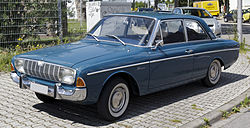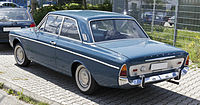Ford P5
| ford | |
|---|---|
|
Ford Taunus 17M (1964-1967)
|
|
| Taunus 17M / 20M (P5) | |
| Production period: | 1964-1967 |
| Class : | upper middle class |
| Body versions : | Sedan , station wagon , coupé , convertible |
| Engines: |
Petrol engines : 1.5–2.0 liters (44–66 kW) |
| Length: | 4585 mm |
| Width: | 1715 mm |
| Height: | 1480-1500 mm |
| Wheelbase : | 2705 mm |
| Empty weight : | 965-1150 kg |
| Previous model | Taunus 17M (P3) |
| successor | Ford 17M / 20M (P7) |
The Taunus P5 (= Project 5, i.e. the fifth new passenger car design by the Ford works in Cologne since the end of World War II) was an upper middle class car from Ford Germany, which was manufactured from August 1964 to December 1967. The sales names were Taunus 17M and Taunus 20M . The "M" means "masterpiece".
Model history
General
The cars with V-engines and rear-wheel drive had independent suspension with MacPherson struts at the front and a rigid axle with leaf springs at the rear. In contrast to the Taunus P4 , the P5 had the manufacturer's name right from the start of construction - still inconspicuous as a small “plum” on the right fender at the bottom next to the designation “Taunus”.
For the Taunus, new V-4 engines (17M: 1.5 l, 60 hp and 1.7 l, 65 hp or 70 hp) and V-6 engines (20M: 2.0 l with 85 hp or 90 PS in the 20M TS). A new "Taunomatic" automatic transmission was available from 1966.
The car was available as a two- or four-door sedan and as a three- or five-door station wagon (tournament) and as a hardtop coupé with a flat rear window and a shorter roof. The body manufacturer Deutsch produced a convertible in small numbers.
The P5 series was replaced by the Ford P7 in August 1967 .
Ford Taunus 20M Cabriolet from German
Technical specifications
| Ford Taunus 17M / 20M (P5) | |||||
|---|---|---|---|---|---|
| model | 17M (1500) |
17M (1700) |
17M (1700S) |
20M (2000) |
20M / TS (2000S) |
| engine | 4-cylinder V-engine (four-stroke) (cylinder angle 60 °), balance shaft |
6-cylinder V-engine (four-stroke) (cylinder angle 60 °) |
|||
| Bore × stroke | 90 x 58.86 mm | 90 x 66.8 mm | 84 x 60.14 mm | ||
| Displacement | 1498 cc | 1699 cc | 1998 cc | ||
| power | 60 hp (44 kW) at 4500 rpm |
65 hp (48 kW) at 4500 rpm |
70 hp (51 kW) at 4500 rpm |
85 PS (62 kW) at 5000 rpm |
90 hp (66 kW) at 5000 rpm |
| Torque | 112 Nm at 2400 rpm |
127 Nm at 2400 rpm |
132 Nm at 2400 rpm |
148 Nm at 3000 rpm |
155 Nm at 3000 rpm |
| compression | 1: 8.0 | 1: 8.0 | 1: 9.0 | 1: 8.0 | 1: 9.0 |
| Carburetor | 1 downdraft carburetor Solex 32 PDSIT 4 with automatic starter |
1 double downdraft carburetor Solex 32/32 DDIST with automatic starter |
|||
| consumption | 10 l - 10.5 l | 12 l - 13.5 l | 12 l - 13.5 l | ||
Top speed (Taunomatic) |
140 km / h | 145 km / h (140 km / h) |
150 km / h (145 km / h) |
158 km / h (155 km / h) |
161 km / h (158 km / h) |
| acceleration | 19.5 sec | 17.5 - 20.5 sec | 16 - 19 sec | 14.5 - 19 sec | 14 - 18.5 sec |
| Tires | 6.40 × 13 | ||||
| Brakes | front disc brakes (242 mm Ø) - rear drum brakes (230 mm Ø, tournament, 20M & 20M / TS 250 mm Ø) | ||||
| circuit | 3-speed steering wheel shift on request (4-speed gearbox and center shift from 05/66 also Taunomatik) | ||||
| Tank capacity | 45 liters (sedan 20M and 20M / TS from 11/66 = 55 liters) | ||||
| Front suspension | MacPherson struts, coil springs, stabilizer | ||||
| Rear axle suspension | Rigid axle on leaf springs | ||||
| Electrical system | Battery 6 V 77Ah, alternator 200 W on request 12 V with three-phase alternator |
||||
| Trunk | 650 liters | ||||
Between August 1964 and July 1967 a total of 710,059 P5 cars were produced. In detail there were 424,331 Taunus 17M, 72,050 Taunus 17M tournament, 170,650 Taunus 20M, 22,418 Taunus 20M tournament and 20,574 Taunus 17M panel vans.
Web links
Individual evidence
- ↑ Werner Oswald : German Cars 1945–1975; 2nd edition 1976 . Ed .: Motorbuch Verlag Stuttgart.




